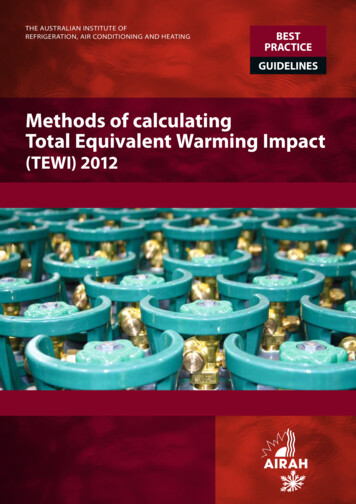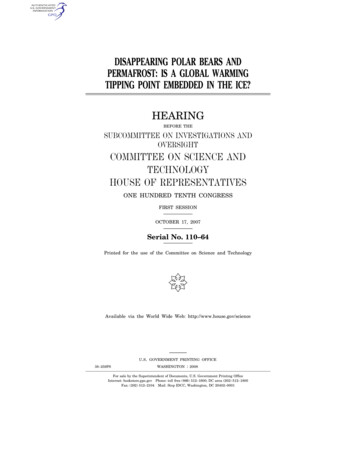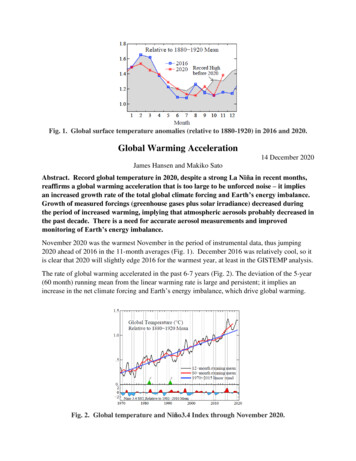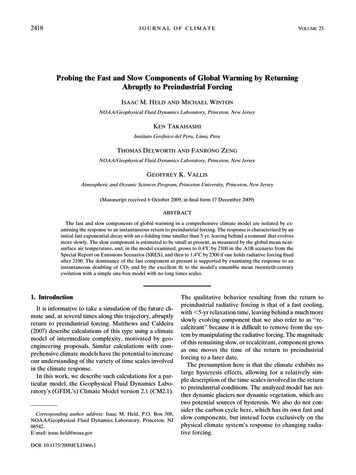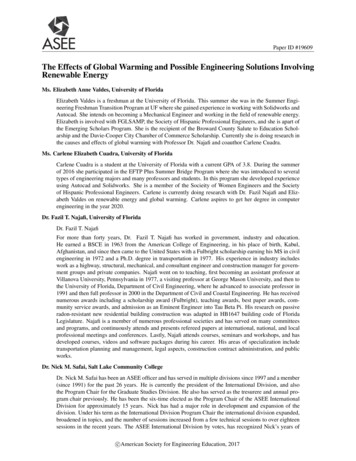
Transcription
Paper ID #19609The Effects of Global Warming and Possible Engineering Solutions InvolvingRenewable EnergyMs. Elizabeth Anne Valdes, University of FloridaElizabeth Valdes is a freshman at the University of Florida. This summer she was in the Summer Engineering Freshman Transition Program at UF where she gained experience in working with Solidworks andAutocad. She intends on becoming a Mechanical Engineer and working in the field of renewable energy.Elizabeth is involved with FGLSAMP, the Society of Hispanic Professional Engineers, and she is apart ofthe Emerging Scholars Program. She is the recipient of the Broward County Salute to Education Scholarship and the Davie-Cooper City Chamber of Commerce Scholarship. Currently she is doing research inthe causes and effects of global warming with Professor Dr. Najafi and coauthor Carlene Cuadra.Ms. Carlene Elizabeth Cuadra, University of FloridaCarlene Cuadra is a student at the University of Florida with a current GPA of 3.8. During the summerof 2016 she participated in the EFTP Plus Summer Bridge Program where she was introduced to severaltypes of engineering majors and many professors and students. In this program she developed experienceusing Autocad and Solidworks. She is a member of the Socieity of Women Engineers and the Societyof Hispanic Professional Engineers. Carlene is currently doing research with Dr. Fazil Najafi and Elizabeth Valdes on renewable energy and global warming. Carlene aspires to get her degree in computerengineering in the year 2020.Dr. Fazil T. Najafi, University of FloridaDr. Fazil T. NajafiFor more than forty years, Dr. Fazil T. Najafi has worked in government, industry and education.He earned a BSCE in 1963 from the American College of Engineering, in his place of birth, Kabul,Afghanistan, and since then came to the United States with a Fulbright scholarship earning his MS in civilengineering in 1972 and a Ph.D. degree in transportation in 1977. His experience in industry includeswork as a highway, structural, mechanical, and consultant engineer and construction manager for government groups and private companies. Najafi went on to teaching, first becoming an assistant professor atVillanova University, Pennsylvania in 1977, a visiting professor at George Mason University, and then tothe University of Florida, Department of Civil Engineering, where he advanced to associate professor in1991 and then full professor in 2000 in the Department of Civil and Coastal Engineering. He has receivednumerous awards including a scholarship award (Fulbright), teaching awards, best paper awards, community service awards, and admission as an Eminent Engineer into Tau Beta Pi. His research on passiveradon-resistant new residential building construction was adapted in HB1647 building code of FloridaLegislature. Najafi is a member of numerous professional societies and has served on many committeesand programs, and continuously attends and presents refereed papers at international, national, and localprofessional meetings and conferences. Lastly, Najafi attends courses, seminars and workshops, and hasdeveloped courses, videos and software packages during his career. His areas of specialization includetransportation planning and management, legal aspects, construction contract administration, and publicworks.Dr. Nick M. Safai, Salt Lake Community CollegeDr. Nick M. Safai has been an ASEE officer and has served in multiple divisions since 1997 and a member(since 1991) for the past 26 years. He is currently the president of the International Division, and alsothe Program Chair for the Graduate Studies Division. He also has served as the tresurere and annual program chair previously. He has been the six-time elected as the Program Chair of the ASEE InternationalDivision for approximately 15 years. Nick has had a major role in development and expansion of thedivision. Under his term as the International Division Program Chair the international division expanded,broadened in topics, and the number of sessions increased from a few technical sessions to over eighteensessions in the recent years. The ASEE International Division by votes, has recognized Nick’s years ofc American Society for Engineering Education, 2017
Paper ID #19609service through several awards over the past years. Nick has been the recipient of multiple Service awards(examples: 2010, 2006, 2004, 1996), Global Engineering Educators award (example: 2007, 2005), BestPaper award (examples: 2010, 2005, 2004, 1995) and other awards from the International Division forexceptional contribution to the international division of the American Society for Engineering Education.Examples of some Awards from other Professional Organizations: American Society of Civil Engineers(ASCE): Engineering Educator of the Year Award 2004. Utah Engineers Council, UEC: EngineeringEducator of the Year 2005 award, in recognition of outstanding achievements in the field of engineeringand for service to society. SLC Foundation; Salt lake City, Utah: Teaching Excellence Award 2004. American Society of Civil Engineers (ASCE): Chapter faculty Advisor recognition award 2002. Computational Sciences and Education; recognition for outstanding contributions and for exemplary work inhelping the division achieve its goals1998. Engineering Division; recognition for outstanding contributions and for exemplary work in helping the division achieves its goals 1995. Science and Humanities;recognition for outstanding contributions and for exemplary work in helping the fields achieve its May1994. Math & Physical Sciences; appreciation for academic expertise February 1994.Academics: Nick Safai received his PhD degree in engineering from the Princeton University, Princeton, New Jersey in 1979. He also did a one year post-doctoral at Princeton University after receivinghis degrees from Princeton University. His areas of interest, research topics, and some of the researchstudies have been; Multi-Phase Flow through Porous Media Wave propagation in Filamentary Composite Materials Vertical and Horizontal Land Deformation in a De-saturating Porous Medium StressConcentration in Filamentary Composites with Broken Fibers Aviation; Developments of New Crashworthiness Evaluation Strategy for Advanced General Aviation Pattern Recognition of Biological Photomicrographs Using Coherent Optical Techniques Nick also received his four masters; in AerospaceEngineering, Civil Engineering, Operation Research, and Mechanical Engineering all from PrincetonUniversity during the years from 1973 through 1976. He received his bachelor’s degree in Mechanicalengineering, with minor in Mathematics from Michigan State. Nick has served and held positions inAdministration (Civil, Chemical, Computer Engineering, Electrical, Environmental, Mechanical, Manufacturing, Bioengineering, Material Science), and as Faculty in the engineering department for the pasttwenty seven years.Industry experience: Consulting; since 1987; Had major or partial role in: I) performing research forindustry, DOE and NSF, and II) in several oil industry or government (DOE, DOD, and NSF) proposals.Performed various consulting tasks from USA for several oil companies (Jawaby Oil Service Co., WAHAOil and Oasis Co., London, England). The responsibilities included production planning, forecastingand reservoir maintenance. This production planning and forecasting consisted of history matching andprediction based on selected drilling. The reservoir maintenance included: water/gas injection and gas liftfor selected wells to optimize reservoir production plateau and prolonging well’s economic life.Terra Tek, Inc., Salt Lake City, UT, 1985-1987; Director of Reservoir Engineering; Responsible of conducting research for reservoir engineering projects, multiphase flow, well testing, in situ stress measurements, SCA, hydraulic fracturing and other assigned research programs. In addition, as a group directorhave been responsible for all management and administrative duties, budgeting, and marketing of theservices, codes and products.Standard oil Co. (Sohio Petroleum Company), San Francisco, California, 1983-85; Senior ReservoirEngineer; Performed various tasks related to Lisburne reservoir project; reservoir simulation (3 phaseflow), budgeting, proposal review and recommendation, fund authorizations (AFE) and supporting documents, computer usage forecasting, equipment purchase/lease justification (PC, IBM-XT, Printer, etc.),selection/justification and award of contract to service companies, lease evaluation, economics, reservoirdescription and modeling, lift curves, pressure maintenance (gas injection analysis, micellar-flooding,and water-flooding), Special Core Analysis (SCA), PVT correlations, petrophysics and water saturationmapping.Performed reservoir description and modeling, material balance analysis. Recovery factors for the reservoir. Administrative; coordination and organization of 2 and 6 week workplans, 1982 and 1983 annualspecific objectives, monthly reports, recommendation of courses and training program for the group.c American Society for Engineering Education, 2017
Paper ID #19609Chevron Oil Company, 1979- 1983; Chevron Overseas Petroleum Inc. (COPI), San Francisco, California1981-1983. Project Leader/Reservoir Engineer, Conducted reservoir and some production engineeringwork using the in-house multiphase model/simulators. Evaluation/development, budgeting and planningfor international fields; Rio Zulia field – Columbia, Pennington Field – Offshore Nigeria, Valenginan,Grauliegend and Rothliegend Reservoir – Netherlands. Also represented COPI as appropriate when necessary.Chevron Geo-Sciences Company, Houston, TX, 1979-1980 Reservoir Engineer Applications, Performedreservoir simulation studies, history matching and performance forecasting, water-flooding for additionalrecovery (Rangeley Field – Colorado, Windalia Field – Australia), steam-flooding performances (KernRiver, Bakersfield, California), gas blowdown and injection (Eugene Island Offshore Louisiana) on domestic and foreign fields where Chevron had an interest, using Chevron’s CRS3D, SIS and Steam Tubesimulator programs.Chevron Oil Field Research Co. (COFRC), La Habra 1978-1979, California. Research Engineer, Workedwith Three-Phase, Three-Dimensional Black Oil Reservoir Simulator, Steam Injection Simulator, Pipeflow#2. Also performed history matching and 20-year production forecast including gas lift and desalinationplants for Hanifa Reservoir, Abu Hadriya Field (ARAMCO).c American Society for Engineering Education, 2017
The Effects of Global Warming and Possible Engineering Solutions InvolvingRenewable EnergyElizabeth Valdes, Carlene Cuadra, Fazil Najafi, and Nick SafaiAbstractGlobal warming is the most important present day environmental issue. It is more thanthe gradual increase of average temperatures. Global warming is the direct result of humanprogression and its consequences, such as the rise in sea levels and the loss of biodiversity, arebecoming prevalent. The primary objective of this research paper is to analyze the causes andeffects that global warming has on the environment resulting from the release of excess amountsof greenhouse gases as well as to compare and contrast many aspects of renewable energysolutions.The greenhouse gases of carbon dioxide, water vapor, methane, ozone, and nitrous oxidetrap some of the solar radiation entering Earth’s atmosphere. Though necessary for life, thepresence of greenhouse gasses have resulted in an increase of global temperatures. TheInternational Energy Agency has projected this increase to be as great as 6 degrees Celsiusresulting in an intensification of desertification and a loss of biodiversity.Since the start of the Industrial Revolution in the 18th century, about 600 thousand milliontons of carbon dioxide have been released into the atmosphere due to the burning of fossil fuelsfor electricity and transportation, leading to a 30% increase in the concentration of carbondioxide in the atmosphere, where it can reside for up to 50 years. At the start of the IndustrialRevolution, humans were not aware of the damages they were doing to the environment.The need for advances in clean, renewable energy is a necessity as the effects of globalwarming become permanent. At the rate of current fossil fuel usage, such energy sources will bedepleted within the next century due to their short lifespan. Renewable energies, in the form ofsolar, biomass, wind, hydropower, and geothermal energy, are paving the way to a moresustainable lifestyle. Breakthroughs in these fields will contribute to the lessening of the negativeimpacts of global warming.The study of the effects of global warming and possible engineering solutions involvingrenewable energy would fit the call in the graduate division and it is consistent with the divisionobjectives. Consistent with the objective above, the subject matter of global warming ismultidisciplinary and directly related to engineering education. Engineering educators andengineering students must be aware of the impacts of global warming and the causes such astransportation, electricity generation, industrial waste, nuclear waste, and many other relevantexisting technologies that contribute to global warming. It is essential for future generations to beeducated in this field. Awareness that our research paper related to the mentioned topic willdefinitely direct it towards this aim. Specifically, creating a carbon free environment that issustainable and cost effective should reduce global warming.
Causes of Global WarmingClimate change is the direct result of human progression. Population increase has led tothe need for more materials, mass production, and more food in order to sustain the growingnumber of people present. To fully understand what is happening to Earth, it is necessary to lookback at the source of the problem.Since the start of the 20th century, human population has skyrocketed. The worldpopulation growth rate for around 800 years prior to this time was rather stagnant, averagingonly about 0.1% growth a year.18 In the 20th century alone, the human population roughlyquadrupled.3 At the start of the 19th century, human population exceeded 1 billion for the firsttime in history.3 It took only 120 years after this for the global population to hit 2 billion in1920.3 In 1960, population hit 3 billion; 4 billion by 1974; 5 billion by 1987; 6 billion by 1999;and 7 billion by 2011.3 In fact, the world population is expected to surpass 9 billion by 2045.3Prior to the Industrial Revolution, human birth and death rates were both high resulting ina low population increase. This changed when death rates began to drop as birth rates rose.3 Forstarters, with the Industrial Revolution came much agricultural advancement. More food wasbeing produced due to new methods of farming including crop rotation and better technologysome of which improved irrigation. Selective breeding made the average size of each farmanimal increase, making meat plentiful and easily accessible. This increased crop and meat yieldled to a decrease in famines and an all-around healthier diet for people, thus increasing lifeexpectancy. Medical care, as well as sanitation, improved, thereby greatly decreasing the numberof deaths associated with disease and illness22 and the use of vaccinations greatly decreasedinfant mortality.3 The greater crop yield lessened the need for farmers and the industrialrevolution opened many jobs in factories resulting in urbanization. Many young people attractedby the higher wages and the jobs available in factories migrated to big cities. This concentrationof young adults made it a lot easier to find a partner and start a family.22 The increase of peoplegetting married and having large families along with an increase in life expectancy and decreasein death rates, led to the population boom witnessed in the 20th century. As the human populationgrew, so did the demand for fuel, food, and space, in turn, leaving a strain on the environment.7The demand for fuel during the Industrial Revolution led to the use of fossil fuels. Fossilfuels are the heated and pressurized remains of deceased plants and animals that have beenburied under Earth’s surface for millions of years. Since these remains are organic matter, carbonmakes up most of their mass. Thus, when fossil fuels combust in the presence of oxygen fromthe atmosphere, the reaction yields carbon dioxide (CO2) as one of its products, which is aleading greenhouse gas.The greenhouse effect is the driving force behind life on Earth. The greenhouse gases ofcarbon dioxide, water vapor, methane, ozone, and nitrous oxide trap some of the solar radiationentering Earth’s atmosphere. Without the presence of these gases, Earth’s average surfacetemperature would be about -6 degrees Celsius which is not suitable for most life on Earth.Though necessary for life as we know it, the greenhouse effect has recently been doing too wellof a job in trapping heat. Since the start of the industrial revolution in the 18th century, about 600thousand million tons of carbon dioxide have been released into the atmosphere due to theburning of fossil fuels for electricity and transportation leading to a 30% increase in theconcentration of carbon dioxide in the atmosphere. The danger behind this gas’s large emissionnumbers is that it stays in the atmosphere for at least 50 years.12 These greenhouse gases
accumulate in the atmosphere at a rate much faster than Earth’s natural processes can removethem, resulting in global warming.About 80% of all primary energy used in the world is derived from fossil fuels. The mostcommonly used forms of fossil fuels are oil, coal, and natural gas. This energy is used foreverything from heating to transportation to electricity. In 2010, an average of about 85 millionbarrels of oil were used per day. The need for fossil fuels is increasing rapidly and is projected tobe around 300 million barrels of oil used per day by 2100.11 Not only does this form of energyincrease the rate at which global warming is happening, but it is also available in a finite amount;therefore, as our dependence on fossil fuels increases, the fossil fuels available deplete. Sincefossil fuels are such a large part of our economy and standard of living, it is clear to see whygreenhouse gas emissions have increased since the start of the Industrial Revolution.The growing need for more food and space that is associated with the world’s growingpopulation can be portrayed through the deforestation of Earth’s tropical rain forests. Reasons fordeforestation include accommodations for increased urban sprawl, logging, highways, money,and agriculture. Most of the land cleared goes to agriculture. Slash and burn techniques forclearing forests are common for plantations.11 This technique, however, is very unsustainablebeing that it releases large amounts of carbon dioxide and aerosols into the atmosphere. Tropicaldeforestation accounts for 25% of the carbon released into the atmosphere. This release ofcarbon dioxide comes from the burning of the above ground biomass and by the release ofcarbon from the soil. During the cultivation phase, soil organic carbon levels can decline by up to30% in the top meter of soil.21 Through deforestation, the possible carbon storage in trees iseliminated and evapotranspiration is decreased. In fact, the complete deforestation of the tropicswould result in a heating that is equivalent to that caused by the burning of fossil fuels since theyear 1850. Not only would temperatures increase, but the rainfall in the US Midwest, Northwest,and South would also decrease during the agricultural seasons, thus negatively impacting cropyield.16Aside from the release of carbon dioxide, another way that deforestation drives climatechange is by increasing the amount of water vapor in the atmosphere. The soil found in tropicalrain forests is naturally very moist. When forests are cleared, the large tree canopies are nolonger present to block the soil from the harsh sun. This results in the evaporation of the soilwater which adds water vapor to the atmosphere, in turn, speeding up the process of globalwarming. Even if this wasn’t the case, terrestrial plants absorb 2.3 gigatons of carbon from theatmosphere per year;12 therefore, the less trees present, the less of the carbon dioxide that is ableto be filter out of the atmosphere, also leaving negative effects on the atmosphere. With thesenumbers, it is worrisome to imagine that land the size of 48 football fields is being cleared fromtropical rain forest every minute.16The agriculture made from deforestation is even more detrimental to the environment.Agriculture alone accounts for one fifth of the annual increase in anthropogenic greenhouse gasemissions which include carbon dioxide, methane, and nitrous oxide. Carbon is released whendead organic matter and plants are removed from the soil and when crop wasted is burned.Nitrous Oxide from agriculture mainly enters the atmosphere through heavily used nitrogenfertilizers.10 Used to increased crop growth, some of the nitrogen in these fertilizers are taken upby the crops. The rest leaches into the surrounding surface, gets denitrified, and then is diffusedback into the atmosphere, thus contributing to global warming. The amount of nitrogen absorbedby the crops varies by plant type; however, wet rice plantations absorbs only about one third of
the nitrogen in the fertilizers. Lastly, methane is produce by the livestock that graze on thesepastures. The second largest contributor to global warming after carbon dioxide is methane.Methane does not get the same publicity that carbon dioxide gets because it is not as plentiful;however, what is not taken into consideration is the absorption power of methane. Methaneabsorbs ten times the infrared energy and heat that carbon dioxide does making it a much morepotent gas.15 Livestock like cattle and sheep are a part of the class of mammals called ruminants.Ruminants have a four-chambered stomach that involve a long process of regurgitating theirfood repeatedly in order to digest it through the different stomach chambers. This processreleases methane. The methane is detrimental to our atmosphere given that there are about 1.4billion cows in the world and each of those cows produce 70 to 120kg of methane per year.20Effects of Global WarmingOne of the main effects of global warming is the rise in sea levels. Over the last twentyyears, the ocean has risen at a rate of about .13 of an inch a year which is nearly double what thenatural increase was in the eighty years prior. This increase in the rate that the sea levels arerising validates the claim that more greenhouse gases are entering the atmosphere than can beremoved. The ocean is responsible for absorbing 80 percent of the excess heat entering theatmosphere, leading to the three main reasons why the ocean is growing. For starters, when wateris heated, its molecules move farther away from each other, causing it to expand. Regardless ofthe water being added to the ocean, the heat itself is causing the same amount of water to take upa lot more space. Another reason for the rise in sea levels is the melting of the polar ice caps andglaciers. The increase of the global temperature is responsible for more ice melting in thesummer than usual and less snow falling in the winter. The surface of artic ice from the NorthPole has decreased by 10% in the last decade and the thickness of ice above water has decreasedby 40%. Lastly, the major ice sheets in Antarctica and Greenland are facing problems similar tothe polar ice caps. The heat melts these ice sheets at a rapid pace and this resulting meltwateracts as a lubricate, causing the ice sheets to move more quickly to the ocean where the warmwater further destroys them. The ocean level has increased in the last decades by 15 cm and it isexpected to rise a meter by 2100.12The consequences of the rise in sea levels is heavily seen from coastal regions andinclude the contamination of aquifers, erosion, loss of habitat for many animals and plants, and,lastly, flooding. Coastal cities like Miami, Florida are already seeing reoccurring cases of severeflooding. In fact, large pumps have been installed in Miami to take out water from the streetsduring high tides. Alas, there is only so much water these pumps can take out of the cities,especially when the warming is expected to accelerate. In fact, at a rising of 30 cm, the salinewaters of the ocean are projected to penetrate the interior of continents by 5-15 km in upsiderivers, infecting estuaries and ruining our drinking water.12The loss of biodiversity is also attributed to global warming. Many species cannot keepup with the rate at which their environments are changing, resulting in the current extinction rateof 100 species extinctions per million species each year. This rate is around 100 to 1000 timeshigher than the backgrounded extinction rate. Biodiversity is necessary in forming complexecosystems that provide provisioning services like the production of renewable resources andregulating services like the lessening of environmental change. Ecological processes inecosystems that control the fluxes of energy, nutrients, and organic matter through anenvironment are made possible by the presence of biodiversity.4 Scientists, doctors, and
researchers also look to plants and animals when trying to come up with a cure for diseases andsicknesses; therefore, the decrease of biodiversity directly affects human medical research.An example of the detrimental effects of a decrease in biodiversity can be witnessesthrough coral reefs. Coral reefs are home to over a million different species and provideecosystem services for over 500 million people. Though home for such a large variety ofanimals, coral reefs are very fragile, being affected by the difference of even 1 to 2 degrees’Celsius change. When temperatures rise, the coral goes into a state of shock and begins tobleach. It expels the chemical responsible for its pigments and turns completely white. If notstopped in time, the corals die from bleaching which can in turn cause a cascade of extinctions.6Cases of coral reef bleaching are becoming increasingly frequent and are expected to increase inrelation to the ocean temperature. The loss of coral reefs will not only leave millions of animalswithout homes, but it will also negatively affect the people that rely on this ecosystem for itsservices.Ocean acidification is yet another threat to marine life and biodiversity. The oceanabsorbs one third of the carbon dioxide released into the atmosphere acting like a “sink”. Overthe past 250 years, the atmospheric carbon dioxide levels have increased by over 40% frompreindustrial levels. This carbon dioxide is causing the ocean’s pH level to decrease, becomingmore acidic. Acidification alters the chemical speciation and biogeochemical cycles of manyelements and compounds. The acidic water is not suitable for many animals but especially shellforming organisms like oysters, lobsters, and even many planktonic organisms. This is becauseocean acidification lowers the calcium carbonate saturation states of the water which reducescalcification and growth rates of shell forming marine organisms.8 Since these organisms are thebasis for many marine food chains, ocean acidification has the potential of affecting all animalsin the ocean.Though it is normal for Earth to receive some form of fluctuations, what is not normal isthe rate at which these changes are occurring and the linkage it holds to people.4 Over the pastmillion years as Earth has moved out of ice ages, the global temperature only rose four to sevendegrees Celsius over the course of 5,000 years. Over the past 100 years, the temperature hasincreased about 0.7 degrees Celsius which is ten times faster than the average rate of ice agerecovery warming. This rate is expected to increase. Predictions estimate that Earth will warmbetween two and six degrees Celsius in the next century which is twenty times faster thanaverage.22These are real, present day, human induced problems. Global warming is much deeperthan the simple rise in temperature. At the start of the industrial revolution, humans were notaware of the damages they were doing to the environment. Now that this information is exposed,it is time for people to begin to take action. Habitat conservation, protection of the endangeredspecies list, and advances in clean, renewable energy are more necessary now than ever before.Solar Power Systems (PV)Over many centuries, there has been a great increase in the demand for electricity generatedspecifically from the solar rays produced by the sun. Countries throughout the world such asGermany, China, and Japan have researched and generated solar power produced fromphotovoltaic solar cells. The generation of electricity using these cells greatly reduces the cost ofthe production of electricity. Although this method manages to save money, it relies heavily onthe weather conditions and its efficiency may be hindered during specific times, seasons, and
locations. In order to improve on this, many solar panels contain photovoltaic collectors toincrease production during times of naturally low productivity. “Waldau (2006) examined theEuropean photovoltaic market and observed a growth rate of 40% increase during a five yearperiod, making photovoltaic production one of the fastest growing industries” (Abolhosseini,Heshmati, & Altmann, 2014). After extensive research on the use of stand alone solarphotovoltaic systems in developing countries by Kolhe, the infrastructure that contained thesesystems functioned at a cost of 15 kWh of energy under unfavorable conditions but wouldincrease to68 kWh/ day in more advantageous conditions. Kolhe then compared the cost of theprod
the Emerging Scholars Program. She is the recipient of the Broward County Salute to Education Schol-arship and the Davie-Cooper City Chamber of Commerce Scholarship. Currently she is doing research in the causes and effects of global warming with Professor Dr. Najafi and coauthor Carlene Cuadra. Ms. Carlene Elizabeth Cuadra, University of Florida





